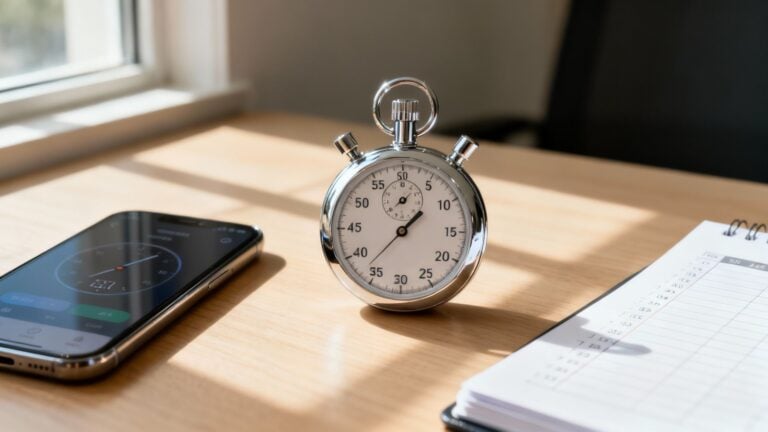Creative agencies have unique needs and challenges when it comes to managing resources, including time and personnel. For instance, as projects progress, team members may become less productive. They might feel burned out, lose interest, or get distracted by new tasks. Whatever the case, if you don’t get a handle on the situation quickly, the project will fall behind, and you may not be able to recover. That’s why project time management is crucial. In this article, we’ll explore the critical role of creative agency resource management in keeping projects on track.
Automatic time tracking software can help you master creative agency resource management, allowing you to get your projects back on track. By automatically tracking time, Tackle provides insight into how your team spends their hours both within and outside the confines of your projects. This data can help you identify problems, reallocate resources, and get your project back on schedule.
What is Creative Resource Management?

Creative resource management is the practice of strategically planning, allocating, and overseeing the time, talent, and tools needed to deliver creative work, whether that’s:
- Design
- Content
- Branding
- Video
- Marketing campaigns
Beyond Traditional Resource Allocation
Creative resource management sits at the intersection of project management and talent management, but with a focus that’s uniquely attuned to the fluid, idea-driven nature of creative work. Unlike traditional resource management, which often prioritises efficiency above all else, innovative resource management must also account for less tangible elements, such as:
- Creative flow
- Inspiration
- Collaboration
That’s why managing a creative team isn’t just about assigning tasks; it’s about understanding each team member’s strengths, innovative rhythm, and availability, and aligning those with the demands of a fast-moving creative pipeline.
Answering Core Questions
At its core, creative resource management helps agencies and in-house teams answer critical questions:
- Who and when is available
- Do we have the right mix of skills to execute this project?
- Are team members overbooked or underutilised?
- How do we balance long-term creative development with short-term deliverables?
Streamlining Creative Workflows
The best creative resource management systems let you visualise team capacity, manage deadlines, assign the right work to the right people, and reduce the friction that often slows down creative processes. They bring clarity to workloads and timelines without stifling the creative energy that drives great work.
Tools for Agile Creativity
Today, many teams use dedicated creative operations software or project management platforms with resource management features. These tools support a more agile, transparent, and collaborative approach, so managers can keep projects on track while giving their teams the freedom and space they need to create.
Related Reading
- Is Time Tracking Effective
- How to Keep Track of Projects at Work
- Project Delivery Management
- Time Tracking Best Practices
- Project Progress Tracking
Why is Creative Resource Management Important?

Spending time understanding your resources and where to use them offers a range of benefits. It helps you plan achievable growth strategies based on your current teams and tools. Resource management also enables you to predict future trends by understanding better what’s happening right now.
If you know you’ve served 10 clients over six months with my five-person team, increasing that team to 10 people could double your profit. A deep understanding of your agency’s resources leads to better business decision-making.
Key Benefits of Effective Agency Resource Management
Improves Productivity
One of the primary benefits of proper resource management is the potential to boost your team’s productivity. We can understand this better by revisiting the example of the sales specialist who is stuck writing forms and performing data entry. This employee is going to be disengaged and not working at their best.
Right Person, Right Role
Beyond a lack of motivation, they don’t know this job as well as their own. They will likely make mistakes, work slowly, and impact both the overall team’s productivity and their own. Put them back into a client-facing role, and they’re likely to shine. When people get to do the things they enjoy and are good at, they’re naturally more productive.
The High Cost of Misallocation
Bolstering that productivity with collaborative software that aids real-time communication is even better. Globally, poor resource management, including the misallocation of team members to tasks, contributes to $8.8 trillion in lost productivity. Focusing on empowering employees to utilise their skills helps keep them engaged and working efficiently.
Increases Profitability
When you can do more and do it better, you have the potential to make more money. A team member who can do their job faster has more free time to be creative and innovative. They might come up with ideas to improve lead generation or temporarily move onto another team to provide auxiliary support.
Team members who aren’t exhausted are also more likely to provide feedback on minor challenges, such as technical issues, unsupportive software, or office conflicts. When workloads are barely achievable, there’s often limited time to work on removing obstacles to growth.
Delivers More Satisfied Clients
Most importantly, agency employees who work smarter deliver better results for clients. Happy clients come back and give you repeat business. Nonetheless, they do far more than this. You can utilise the reviews and feedback of satisfied clients to improve your current and future marketing campaigns.
Ensure you obtain the consent of your clients before using their testimonials in this manner. Consider creating a feedback form with a checkbox that obtains consent, and send the form to clients at the end of every project.
Client Insights
Aside from gaining valuable earned media through positive comments, this can further direct your agency’s resource management strategy. You get a snapshot from the client’s perspective of what’s working and what’s not, allowing you to hone your processes and agency workflows.
Better Talent Retention
While client satisfaction is vital, it’s also essential for agencies to focus on retaining their top talent. Recruitment experts state that a “laser focus” on candidate experience is a primary factor for attracting new hires. Nevertheless, you also need to concentrate on retaining your current employees.
It costs significantly more to train a new team member than it does to retain an existing one. Failed retention strategies are an instant drain on agency budgets.
Strategic Skill Alignment
Resource management enables you to allocate tasks to the right individuals, leveraging their skills and experience to maximise efficiency. It also helps you see where skills gaps exist and offer appropriate training and development. Continuous education can be a significant factor in an individual’s decision to remain with their employer.
Scalability
When you have a good understanding of the resources available to your agency, you can quickly scale your efforts up to meet increasing demand. Hopefully, your business is gaining interest from new leads every day. You want to be able to promptly engage those leads, following up on queries and sending emails or messages where appropriate.
Readiness for Growth
Without team members in place to perform those tasks, those potential clients may choose to go with a competitor. Again, it’s about having your resources in the right place at the right time. Combine digital tools with skilled employees to create marketing campaigns that effortlessly scale up.
Healthier Employees
Employees at a desk with laptops laughing, they’re probably happy due to effective agency resource management. Making employees available to highlight their skills while performing tasks they find engaging could positively impact their health. Team members who are constantly asked to do work outside their remit or above and beyond reasonable workloads are at risk of burnout.
Well-being and Retention
Conversely, individuals who feel engaged in their work and like they’re an effective part of a team report higher levels of well-being. A healthier workforce is more productive and loyal. Your agency’s resource management strategy is a critical aspect of caring for your teams and showing them that they’re valued.
AI-Powered Automation for Optimal Time Management
Tackle revolutionizes time tracking through seamless calendar integration, eliminating the need for manual logging.
Key Features
- Automatic time capture and categorisation.
- Intuitive dashboards and actionable insights.
- Innovative tagging system tailored to your workflow.
- AI-powered automation for repetitive tasks.
- Flexible reporting tools to track what matters.
- Intelligent time capture directly in your browser.
Trusted by Leading Teams
Teams at Roblox, Deel, and Lightspeed Ventures rely on Tackle to optimise time allocation.
Who Benefits
Perfect for executives, team leaders, and customer-facing professionals aiming to:
- Track strategic initiatives
- Measure team efficiency
- Optimize resource allocation
Easy Setup
- Connect your Google or Outlook calendar.
- Set up custom tags and automations.
- Gain valuable insights into time usage.
Start for Free
Tackle transforms time tracking from a chore into a powerful decision-making tool. Start using our automatic time tracking software for free with one click today!
Related Reading
- Client Project Management
- Best Project Management Software for Creative Agency
- Agency Resource Management Software
- Best Agency Project Management Software
- Monday.com vs Basecamp
- Monday.com vs Jira
6 Best Practices for Creative Resource Management for Agencies

1. Understand Why Proper Resource Management is Worth Your Time
No matter what undertaking you decide to follow in your creative agency, there’s always a key question to ask before getting started:
Why?
Why does resource management even matter in a creative agency, especially one that’s still delivering a quality service to its clients? The answers are numerous and primarily focus on improving an existing agency, even one that is already functioning well.
Navigating Workload Limits
By building better resource management processes, you develop an understanding of your agency’s current and maximum capacity. Both are crucial. Current capacity tells you how much work you can take on before hitting a breaking point, with maximum capacity being a helpful indicator of when you’re taking on less work than you can handle.
Scaling and Surge Preparedness
Once you know your maximum capacity, you know how far I can scale before I need to hire more staff, invest in new technology, or otherwise expand the internal workings of my agency. I’ll also see whether I’m capable of dealing with a sudden surge in demand. If I’m already at maximum capacity, then there’s no chance I can take on more.
Effective resource management is crucial to your project planning and revenue forecasting. Both require you to know what you have, both in use and available, before you can create accurate reports.
2. Spot the Signs of Poor Resource Management
Now you know why resource management is so important; it’s time to figure out if you have a problem with this vital aspect of creative agency management. Thankfully, though unfortunately for those agencies that struggle with managing resources, there are a few signs:
High Client Turnover
An inability to deliver what a client asks is usually a symptom of high client turnover rather than the chief cause. Usually, ineffective resource management lies at the root of your turnover problems. It means I’m unable to deliver because I don’t have the necessary resources to dedicate to a client.
Trust erodes. Clients become unhappy because they’re not getting the attention they require. And my lack of resource planning sees many of them waving “bye-bye.”
Lack of Growth
Stagnation is the enemy of a growing agency, but it’s precisely what you’ll see when you have poor resource management practices. The reason is simple – you need resources to scale. If you don’t have them, or don’t know what I have available, your agency can’t grow, no matter how talented your team and how superb your service may be.
Employee Burnout
According to Deloitte, 77% of your current employees will have experienced burnout at some point in their careers. Some may be experiencing it right now. If that’s the case, you likely have a resource management issue. Again, the reason is simple. Lack of resources leads to piling more onto the plates of people who are already working at or near full capacity.
They get stretched beyond their capabilities, and you start to see tired employees whose morale has reached an all-time low.
Low Employee Retention
What do employees do when they’ve reached the end of their ropes? They either quit or shut down to the point where they’re unable to perform to the level your creative agency requires. Just as with clients, if you’re struggling with high employee turnover rates, you have another symptom of poor resource management.
So, the tip here is simple. Look for these four signs in your creative agency. If you spot even one of them, you’ve seen an indicator that you need to get your resource management practices under control.
3. Set and Track Utilisation Goals
The concept of a utilisation goal is to set a target, either for individuals or your agency as a whole, that enables you to make the best possible use of the available assets. They can be implemented in every aspect of your agency, from its general service capacity to your use of tools and your employee productivity.
Billable Utilization
Think of them as key performance indicators (KPIs) for resource management. Honing in on your people, focus on time spent on billable work as a utilisation goal. In a perfect world, you’d be able to pay 100% of an employee’s time, which is the resource you’re tracking here, for work that generates money. But the reality is that this is impossible. Employees have to attend meetings.
They need to handle paperwork, participate in training, and manage both internal and external correspondence.
Setting Realistic Utilisation Goals
As such, a realistic utilization goal for an employee’s billable hours falls within the 70% to 80% range. Of course, this also depends on their role within your creative agency. For instance, admin and accounting staff will have far fewer, if any, billable hours because their work is internally focused.
For them, utilisation goals may relate to the number of reports generated or ensuring invoices are sent to clients on time.
Tracking and Troubleshooting Utilisation
Whatever the case may be, set your utilisation goals across the company and track them. Whenever you see the baseline I’ve set isn’t being hit, you’ve found another indicator of a resource management issue.
4. Use Resource Management Software
When it comes to creative agencies, you have three key resources to manage:
- Time
- People
- Budgets
All factors must be considered when creating projects and assigning tasks, as many agencies still use manual processes, such as manually tracking resource utilisation in spreadsheets, to monitor resource usage.
Embracing Automation for Efficiency
Don’t do that. Manual processes waste enormous amounts of time, especially when you have the option of agency or resource management software available to you. These software tools help you to schedule projects, keeping your people’s available time in mind, while ensuring those projects meet your budgetary requirements.
But crucially, all the information used is centralised within a single piece of software, with automation built in to alert you when you’re stretching a resource too far or not using it enough.
Take Basic Project Timelines as an Example
You may have several projects running simultaneously, all of which require website design. Your agency only has one designer, so you naturally assign them to every project. With resource management software, I can ensure that this valuable resource isn’t tasked with completing web designs for all running projects simultaneously, thereby addressing the capacity issue.
Capacity Alerts and Expansion Needs
And, if avoiding having that designer go overcapacity isn’t an option, the software’s essentially telling me that I need to hire another designer to deal with my workload. Of course, the main drawback to these software solutions is cost. Most run on the “software as a service” (SaaS) model, meaning you’ll pay a monthly subscription fee to use them. Prices vary widely.
5. Establish Strong Communication Protocols
Email still dominates the workplace, even in an age when we have project management and communication tools, such as Slack, to streamline communications. CIO Dive points out that email is used in 91% of cases where employees need to communicate, which can be problematic from a resource management perspective.
Why?
Email often leads to fractured communication, especially once you get to the point where I’m cc’ing multiple people into a thread. That’s usually the case for large creative agency projects, for which you could easily have a dozen stakeholders.
The Cost of Fragmented Communication
This fracturing, which includes missed messages and slow responses from people who aren’t checking their emails, leads to delays, causing your key resources (your people) to sit idle. Countering that with a stronger communications protocol, such as “send questions via email,” is key. Good project management software, such as Slack mentioned above or an agency-specific tool, often helps in this regard.
Real-time Communication
By offering real-time chat tools with built-in notification systems, they enable project teams to ask and answer questions quickly, reducing delays and ensuring your agency meets the utilisation goals mentioned earlier.
6. Assess and Evaluate After Every Project
So, you’ve set utilisation goals, meaning you have some KPIs in place for your people. You’ve even invested in resource management software that allows you to assign resources—people, time, and budgets—to specific projects.
Continuous Monitoring
Everything’s running like clockwork, right? Well…hopefully. As detailed as your resource management protocols may be, they’ll never be “set and forget” rules for your agency. Even with those protocols in place, you have to constantly monitor them to ensure your resources are being used effectively at all times.
The best time to run one of these assessments is in the immediate aftermath of a project. Once you’ve completed and delivered your service to your client, schedule a “wash-up” meeting that brings everybody who worked on the project together.
Time Deviations
The focus of this meeting is simple: figure out what you could improve for future projects. For instance, let’s assume you projected to spend 40 hours on the project. Nevertheless, upon completion, your resource management software indicates that I spent 45 hours, meaning I’ve used up five hours of my valuable time, which could have been dedicated to other billable work.
Learning from Time Overruns
Those five hours may have been the result of a new requirement from the client, in which case I’ve hopefully tracked it in my software. Or, it could demonstrate that I under-assigned resources, leading to delays, which is a problem I’ll have to confront in my next project.
Assessment and evaluation inform my future resource planning, helping me refine what I have so that my creative agency is as efficient as possible.
5 Creative Resource Management Software for Agencies
1. Tackle: The Smart Time Tracking Tool for Creative Agencies
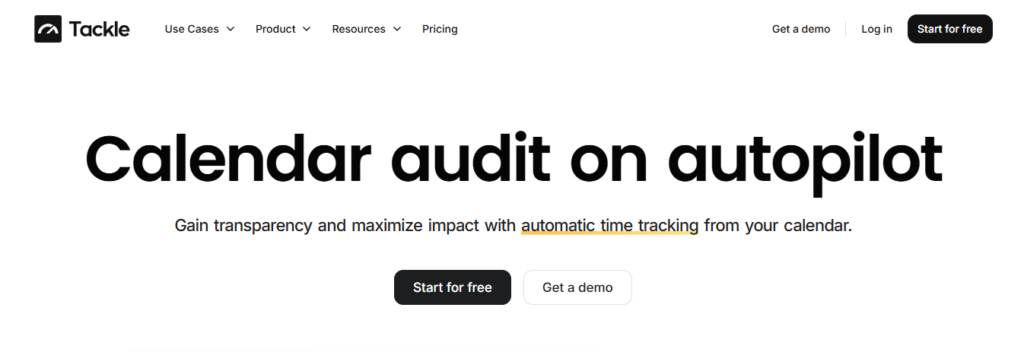
Tackle goes beyond time tracking to offer a complete creative resource management solution for agencies. The software automatically tracks the time creative professionals spend on different tasks by integrating with your Google or Outlook calendar.
Tackle eliminates the need for manual time logging, allowing creative teams to focus more on their projects. The platform automatically:
- Captures meetings, tasks, and time blocks
- Categorizes them using a custom tagging system tailored to your agency’s workflows.
Smart Automation for Time Insights
With intelligent automation features, you can set rules to tag, group, and report on time usage without lifting a finger. Tackle turns your calendar into a source of truth for operational insight, whether you’re:
- Managing client deliverables
- Tracking billable hours
- Allocating internal resources
Clarity for Agency Leaders
What sets Tackle apart for agencies is its flexibility and clarity of purpose. Agency leaders and project managers can explore intuitive dashboards that reveal how time is distributed across clients, projects, or teams, helping you identify underutilised resources, prevent burnout, and forecast workloads with greater accuracy.
Customisable Reporting and Trusted Results
You can customise reporting to match client reporting requirements or internal KPIs, streamlining both project oversight and stakeholder communication. Trusted by companies like Roblox, Deel, and Lightspeed Ventures, Tackle empowers creative teams to turn time data into actionable insights.
Frictionless and Accurate Tracking
By automating the time tracking process, it removes friction and ensures your data is accurate and up-to-date, without interrupting the creative flow. For agencies seeking to manage time and resources more effectively, Tackle provides a fast and user-friendly entry point: simply connect your calendar, configure your tags and automations, and let the platform do the rest.
Start using Tackle’s automatic time tracking software with one click today and turn your time data into a strategic asset.
2. Bonsai: A Simple Yet Powerful Agency Resource Management Software
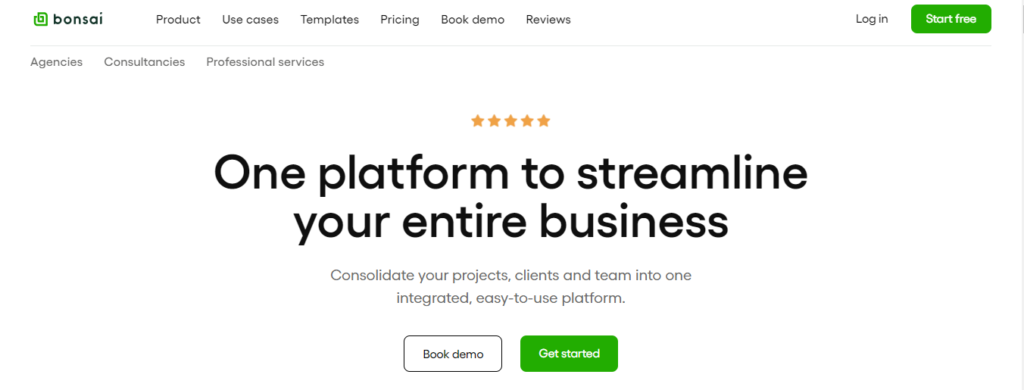
Bonsai is an all-in-one business management platform designed to streamline business workflows, with features handy for digital and creative agencies, consultancies, and professional service providers. As an agency resource management software, Bonsai’s platform allows you to manage your projects and related operations from beginning to end.
Real-time Capacity and Optimisation
You can plan project tasks around your team’s capacity using the platform’s workload chart, which offers a real-time view of availability. The software also features robust reporting and analytics capabilities that enable you to optimize your resources more effectively.
For example, through its time tracking feature, Bonsai can provide insights into the actual time spent on tasks compared to the time planned, offering a better overview of utilization and overall profitability. These reports are also helpful for forecasting future resource needs.
3. Kantata: A Comprehensive Platform for Creative Agencies
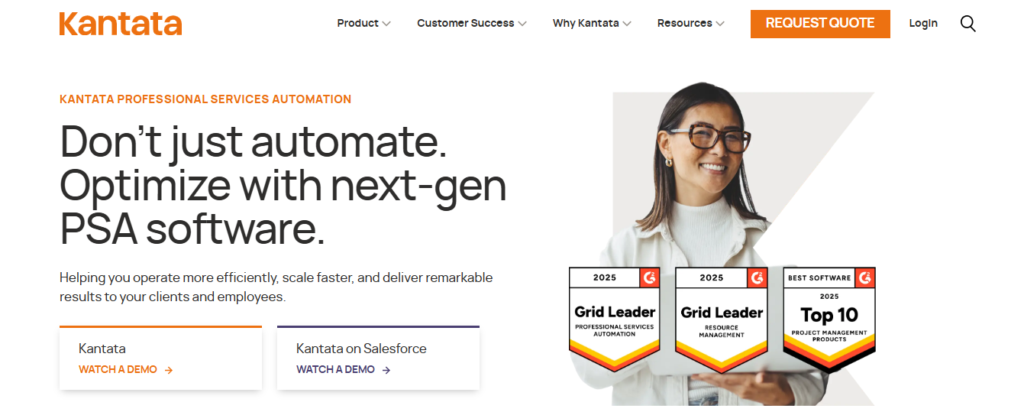
Kantata is an agency resource management software that combines project accounting, analysis, planning, and execution into a single platform. If you’re looking for a tool that can do it all, look no further than Kantata. The platform features:
- Modules for project management
- Business intelligence
- Team collaboration
- Accounting
- Resource management
Integrated Dashboards and BI Consulting
All of which are integrated into a unified system of dashboards. Users can view real-time utilisation at both the task and project levels, and can also track time and expenses. Kantata offers clients access to their BI consultants, who can provide further data by building custom reports and providing onboarding training to your team.
The platform features resource forecasting, scenario planning, role-based planning, skills management, and capacity management.
4. Scoro: The All-In-One Work Management Software for Professional Services
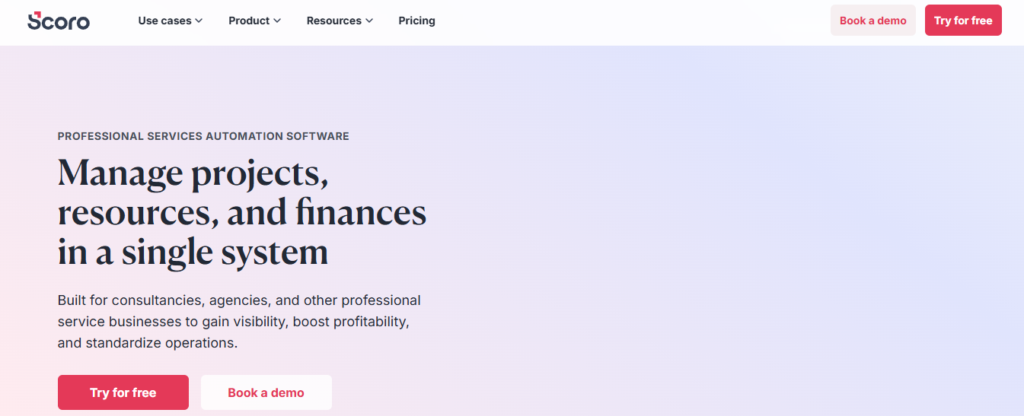
Scoro is an all-in-one work management software designed for professional services, offering a comprehensive range of features to streamline processes and enhance productivity. One of the key features that makes Scoro ideal for agencies is its all-in-one platform, which eliminates the need for multiple separate tools.
Integrated Agency Operations
This integration ensures that all aspects of agency operations, from project management and time tracking to financial reporting, are seamlessly connected. The software provides detailed insights into project progress, resource allocation, and economic health, all accessible from a single, real-time dashboard.
Comprehensive Project Oversight
Scoro’s robust project management capabilities are specifically tailored to meet the needs of agencies that require precise control over their projects and resources. The software enables managers to assign tasks, track time, and monitor deadlines and budgets in real time, providing a comprehensive overview of ongoing projects.
5. Monday.com: Creative Resource Management Software Built for Marketing Agencies

Monday.com is a project management software with a creative management tool built specifically for marketers. Monday.com is a flexible platform that enables marketing agencies to view projected timelines, outstanding projects, and available resources. The simple, well-designed interface is easy to learn, allowing teams to get started planning and tracking right away.
The handy workload view will enable you to see team capacity and make any necessary adjustments to ownership or timeline. Monday Marketer offers marketing-specific features designed to meet industry needs.
Centralised Creative Hub
You can collect and manage creative requests, monitor projects, review briefs, and even upload digital assets. The tool also speeds up the approval process by allowing you to annotate images and videos.
Related Reading
- Microsoft Project vs Trello
- Monday vs. Asana
- Monday.com Competitors
- Jira vs Basecamp
- Basecamp Competitors
- Bonsai Alternatives
- Asana Alternative
- Trello Alternative
Start Using Our Automatic Time Tracking Software for Free with One Click Today
Tackle revolutionises time tracking through seamless calendar integration, eliminating the need for manual logging. Our platform automatically captures and categorises your time, providing actionable insights through intuitive dashboards and reports.
We’ve built everything you need into one seamless package: an intelligent tagging system that works your way, AI-powered automation to handle the tedious stuff, flexible reporting tools to track what matters, and smart time capture right in your browser.
Trusted by Industry Leaders
Trusted by teams at Roblox, Deel, and Lightspeed Ventures, Tackle helps executives, team leaders, and customer-facing professionals understand and optimise their time allocation. Simply connect your Google or Outlook calendar, set up custom tags and automations, and gain valuable insights into how your team spends their time.
From Chore to Catalyst
Whether you’re tracking strategic initiatives, measuring team efficiency, or ensuring resource optimisation, Tackle transforms time monitoring from a chore into a powerful decision-making tool.
Start using our automatic time tracking software for free with one click today!



